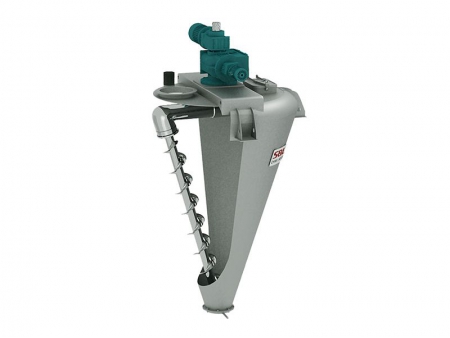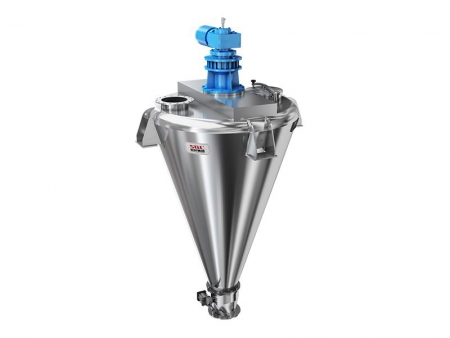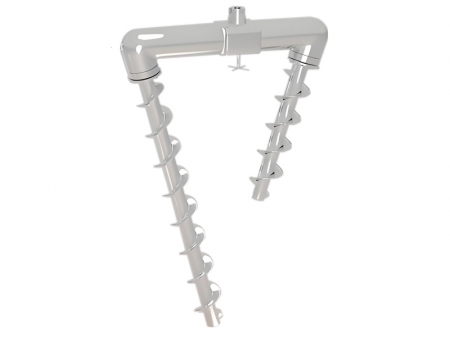Conical Screw Mixer
Vertical cone screw blender for batch processing powders, pastes and liquids
Conical screw mixer, also known as Nauta Mixer, cone screw mixer, vertical screw mixer, consists of one or two asymmetric screws. The vertical cone screw blender is a batch mixer, specially designed for batch processing of powders, pastes and liquids. The screws rotate around their own axis (rotation) while, with the help of the rotation of the cantilever, they revolve around the central axis of the cone vessel along the inner wall of the vessel (revolution).
The equipment repeatedly lifts the material through the rotation and revolution of the screw, producing complex movements such as shearing, convection, and diffusion in the vessel, thereby achieving uniform mixing. This cone screw mixer is featured by wide applicability, large capacity, residue-free discharge, and energy saving.
S&L conical screw mixer is ideal for batch mixing and blending of powders, pastes and liquids of the food, pharmaceutical, chemical and feed industries.
S&L conical screw mixer is suitable for mixing and blending powders and powders, particles and powders, as well as powders and small amounts of liquid additives. The mixing machine has a wide adaptability for mixing coarse powders, fine powders, fibrous or flakey materials., and will not cause overheating of heat-sensitive materials, and can keep particles as intact as possible.
Pressure/vacuum inside mixer, Jacket for cooling or heating
| Gross Volume (L) | Effective Volume (L) | Overall Dimensions (mm) | Shaft Speed (rpm) | Approx. Weight (kg) | ||
| A (length) | B (width) | C (height) | ||||
| 100 | 40-60 | 670 | 670 | 1300 | 118 | 250 |
| 300 | 120-180 | 934 | 934 | 1900 | 119 | 450 |
| 500 | 200-300 | 1106 | 1106 | 2200 | 119 | 550 |
| 1000 | 400-600 | 1509 | 1509 | 2800 | 97 | 1100 |
| 1500 | 600-900 | 1662 | 1662 | 3000 | 97 | 1300 |
| 2000 | 800-1200 | 1844 | 1844 | 3300 | 97 | 1450 |
| 3000 | 1200-1800 | 2071 | 2071 | 3500 | 97 | 1600 |
| 4000 | 1600-2400 | 2314 | 2314 | 4000 | 74 | 2550 |
| 5000 | 2000-3000 | 2457 | 2457 | 4150 | 74 | 2800 |
| 6000 | 2400-3600 | 2603 | 2603 | 4400 | 74 | 2900 |
| 8000 | 3200-4800 | 2850 | 2850 | 5000 | 74 | 4350 |
| 10000 | 4000-6000 | 3088 | 3088 | 5300 | 72 | 5600 |
| 12000 | 4800-7200 | 3267 | 3267 | 5600 | 72 | 6150 |
| 15000 | 6000-9000 | 3505 | 3505 | 5950 | 72 | 6600 |
| 20000 | 8000-12000 | 3833 | 3833 | 6500 | 56 | 10150 |
| 25000 | 10000-15000 | 4115 | 4115 | 7000 | 56 | 11000 |
| 30000 | 12000-18000 | 4359 | 4359 | 7400 | 56 | 12000 |
-
Mixing system
Standard conical screw mixer consists of two screws, one long and one short. In practical applications, depending on the equipment specifications, it can also be equipped with a single screw (one long screw) or three screws (two short and one long, symmetrically arranged). -
Heating/cooling jacket
Various types of jackets can be added to the outer body of the mixer, allowing for the cooling or heating of the material by injecting cold or hot media into the jackets. Cooling is typically achieved by pumping industrial water into the jackets, while heating can be achieved by introducing steam or thermal oil. -
Liquid injection
Above the choppers, atomizing nozzles can be added to achieve liquid addition mixing. Due to the lower density of the material under the shear of the choppers at this position, the atomized liquid is more easily able to penetrate and mix with the powder material. -
Lip
The vessel lip can be made into a head-type, and the vessel body can be thickened to withstand positive or negative pressure. This design can reduce residue and facilitate cleaning, making it a common setting for vessel bodies that require pressure resistance. -
Feeding method
Manual feeding, vacuum feeder, and conveyor feeding are available. In specific processes, the vessel can be designed as a negative pressure chamber. Using a hose, free-flowing dry materials can be sucked into the vessel for blending. This setup can help avoid residue and contamination during the feeding process. -
Discharge valve
The standard discharging uses a "lobe valve" that is closely fitted to the bottom of the long screw, effectively reducing dead corners in the mixing process. The valve can be manually or pneumatically operated. Depending on customers’ requirements, S&L offers various outlet valves to choose from, such as butterfly valves, ball valves, star-shaped discharge, and side outlet can be installed.
Conical Mixer with CIP
S&L conical screw mixer is equipped with a Clean-in-Place (CIP) system to enhance its performance for hygienic production. This system allows for thorough cleaning of the mixer without disassembly. It involves installing washing devices and performing manual preparatory steps to initiate the cleaning process. The CIP system operates in a fully automated mode through programmable logic control (PLC), ensuring complete cleaning. After wet cleaning, it is essential to dry the mixer using air. By utilizing the CIP system, cross-contamination between batches can be prevented, thus ensuring the quality of the finished products.
Conical Mixer with Jacket
The dimple jacket is a commonly used type of jacket for dryer mixers. It consists of a thin external shell attached to the vessel shell using spot welds. The cooling or heating medium flows through the jacket, allowing for temperature control of the mixer. With advancements in material processing, mixers are increasingly being used for multi-functional mixing purposes. A dryer mixer can be utilized for mixing materials with a maximum water content of 70%, which can then be dried through the heating jacket combined with vacuum technology. In some cases, the drying effect can reduce the water content to as low as 0.05%. The basic design of a dryer mixer involves a stationary horizontal cylinder that is loaded from the top and discharged from the bottom. The standard mixing tools are plow-shaped and radiate from a horizontal shaft supported by outboard bearings. Other mixing tool designs are also available to suit specific requirements.
Operating based on the proven "fluidized bed" mixing principle, this dryer maintains the materials in a mechanically fluidized suspended state. This allows for intimate contact between reacting mediums, such as gas-solid or liquid-solid, and facilitates efficient heat transfer between them and the heat transfer surfaces of the mixer.
Cooling or heating: Various types of jackets can be added to the outside of the mixer cylinder to achieve cooling or heating of the materials by injecting cold or hot media into the jackets. Cooling is typically achieved by pumping industrial water, while heating can be achieved by introducing steam or thermal oil.
Conical Mixer with Retractable Rotor
In a hygienic mixing environment, the screw agitator pull-out design is an ideal choice. This design allows for easy access to the mixing chamber, reduces downtime for cleaning, and prevents cross-contamination between batches. The driven system ensures that the top cover and vessel can be easily separated, facilitating efficient cleaning of the mixer. The screw agitator pull-out design is particularly useful for dealing with sticky materials that may adhere to the vessel or agitator. This design provides a good way to ensure complete cleaning, thereby avoiding any potential pollution or cross-contamination issues. Additionally, this design allows for quick and easy receipt changing, enabling users to increase the efficiency of their mixing processes.
- Continuous blending or batch blending method: Batch processing allows for traceability.
- Batch size: It is important to find the right balance, as an excessively large batch may result in uneven mixing.
- Mixing time: Shorter mixing times lead to lower processing costs and reduced degradation of sensitive materials. However, a balance must be struck between mixing uniformity and cycle time.
- Power consumption: Energy efficiency is crucial. S&L has extensive experience in designing energy-efficient mixing and blending systems.
- Easy discharge: Discharge capability is one of the key functionalities of batch mixers. It is essential to ensure complete discharge of the blended material without any residual.
- Easy cleaning: Proper cleaning is vital to an equipment for mixing and blending different materials. S&L industrial mixers & blenders are integrated with CIP (Clean-in-Place) systems for easy cleaning. When selecting a mixing & blending system, please inform our technical experts about your requirements. They will provide suitable recommendations to minimize your procurement costs and maximize the equipment efficiency.




